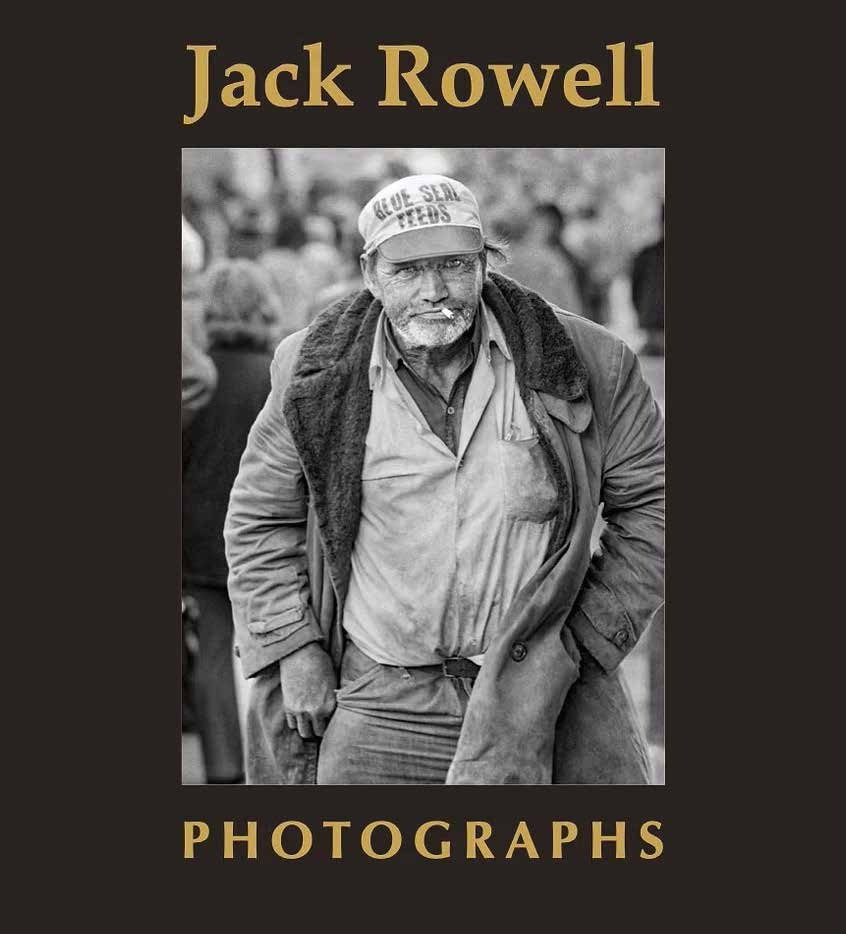 One of Rowell’s earliest photos, “Man on the Midway” (1973), serves as the cover photo for his new photo book. Photo courtesy of Jack Rowell
One of Rowell’s earliest photos, “Man on the Midway” (1973), serves as the cover photo for his new photo book. Photo courtesy of Jack Rowell
This story by Isabel Dreher was first published in The Herald on Nov. 6, 2025.
Photographer Jack Rowell is on the verge of releasing his magnum opus — that’s what his publisher calls it, anyway, he said. The project is a 121-page book of photos, an epic of Rowell’s favorite images of his career.
“It gave me an opportunity to archive what I’ve done for the past 55 years, which I never would’ve done,” he said. “It’s my legacy, and I hope people like it.”
Sara Tucker, who owns a local book publishing company, Korongo Books, is publishing Rowell’s photography book. “He calls himself a cultural documentarian. He says it a bit tongue-in-cheek, but that is really what he is,” she said. “As a photographer, he has documented and preserved part of Vermont culture.”
Tucker and Rowell went to high school together and their professional relationship is built on decades of friendship. For Tucker, as a lover of stories, having a local publishing company is a way to share the important stories of Vermont. That, she says, is exactly what Rowell does.
“I think its important for individuals to give us their perspective on a given period of time and place,” she said. “His perspective on the 50 years that he’s been largely a documentary photographer is an important part of our story. So in sharing it, he’s sharing a part of our common heritage, and it’s important to capture that and preserve it.” Rowell speaks with a thoughtfulness gained by decades of observing people around him. It’s something he’s done through the lens and beyond, evidenced in his ability to share detailed stories of every face on the pages of his book.
The coffee table-style book, which will be released on November 22, has taken Rowell three years to compile. While he gives high praise and credit to his publisher and designer, much of the beginning of the process was undertaken alone as he went through decades upon decades of archived photos, including the thousands of rolls of film that dominated his career until the early 2000s.
One notable photo, unearthed from the depths, was one he called “Man on the Midway,” an image that Rowell took at the Tunbridge Fair in 1973. Centered in the frame is the figure of a man with one hand stuffed in the pocket of his large coat. A cigarette hangs lazily out of his mouth, in contrast with the intensity of his eyes, bordered by the lines etched in skin from the sun and smiles that are trademarks of the life of a hard-working Vermonter. A cap is pulled low on his forehead.
The photo’s publication potential though, was not always guaranteed. It suffered damage in its time as a negative that Rowell said he wouldn’t have been able to repair before Photoshop came along. “Somehow I knocked that negative onto the floor and stepped on it, and it had these huge gouges. I mean, the emulsion was literally gone. … It was just black,” he said.
“It’s a very powerful image,” Rowell said. “It was the last photo on the roll. … We used to hand roll our own film then, and where the film would stick out and you’d attach it to the cassette would get exposed, so it was white. You can almost see a little bit of that white there.” He ran his finger along the top of the photo.
One of the things that makes that image, and, in fact, many of Rowell’s photos, so striking, is the way he captures his subjects’ faces. “Remember,” he said, “the eyes are the key.”
Life with Fred
In the 1990s, Rowell became an associate producer on “Man With a Plan,” John O’Brien’s 1996 film about Fred Tuttle, the real-life Tunbridge farmer and his fictional run for U.S. Congress. Tuttle occupies his fair share of pages in Rowell’s book.
“This was before the movie came out,” he said, poring over one of the book’s final pages, an image of Fred Tuttle in front of the U.S. Capitol building, which ultimately became a movie poster for “Man With a Plan.”
“We went to D.C., and we did it just in time too, because they replaced parts of the dome after that, and the Capitol was shrouded. This was all scaffolding,” he pointed to the grand white dome behind Tuttle. “I posed Fred on a knoll in front of the Capitol, and I had some trouble dealing with light, because it was sunny out, but then it got a little overcast.”
After the release of the film, Tuttle did actually make a run for U.S. Congress during which Rowell continue to photograph him, including for People Magazine. Tuttle ended up endorsing incumbent Patrick Leahy and losing the race.
Shifting style
Rowell grew up in Groton, moving to Randolph by the time he started high school. He was a heavy drinker and smoker, but gave up both vices decades ago.
Later in his career, Rowell began to focus more on studio photography. He has a small studio in Randolph, and the latter half of his book features many photos taken there or in other studios nearby. Rowell said his photos became more focused after he stopped drinking, and many of those shots represent that time.
However, Rowell has always stuck with a mantra about his favorite photographic subjects. “I just came up with this once when this artsy-fartsy type asked me. … My favorite things to photograph, that would have to be big fish and good looking women,” he said.
When asked if that was really true or just something he likes to say, Rowell gave a shrug. “Its kinda true,” he answered with a laugh.
Bringing ‘Jack Rowell Photographs’ to life
The photos in the book span from 1973 to 2025. Some of his first-ever photos are featured, like one of a pair of laughing men perched on the back of a garbage truck, taken in Braintree when Rowell was 18. The most recent photo in the book was taken in May of this year, and features Mary Frances Leahy playing fiddle at at the Chandler Music Hall. The 19-year-old daughter of Celtic fiddler extraordinaire Natalie MacMaster (whom Rowell has photographed many times and who is also featured in the book), Leahy stretches across a wide frame with her right arm extended away from her fiddle, the bow blurred as she quickly draws it far from the strings. Her body is angled, almost as if in a triumphant bow, but her gentle smile looks proud as she keeps eye contact with the audience. As Rowell says, the eyes are the key.
It was important to everyone, Tucker said, to keep the book’s production as local as possible. She was able to find a printer in Lewiston, Maine. As of publishing, the books are available for pre-order and cost $85 dollars each through the end of the year.
“Photography is [Jack’s] thing. It defines him, but he’s also incredibly generous as a person and as a photographer. It’s all one thing, meaning his art, his photography, really does serve the community,” Tucker said. “The people he’s interested in are people who are doing an outstanding job at something, or they’re just very intriguing interesting people who have caught his attention.
“And so his instinct is to tell the world about what he finds valuable,” she continued, “and to me, that’s a very generous act, and he does a beautiful job.”
The White River Craft Center in Randolph will host a launch party on November 22 from 2–5 p.m. Preordered books will be available then for pickup and may be signed by Rowell at the party.
Latest stories
by Auditi Guha
November 6, 2025, 6:16 pmNovember 6, 2025, 6:16 pm
by Erin Petenko
November 6, 2025, 2:51 pmNovember 6, 2025, 2:51 pm



